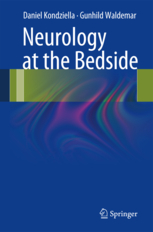by Veronika Rutar Gorišek
A book review
A must for a neurology resident
Imagine having a friendly collegue you can ask almost anything, yet will answer with wisdom and accuracy of an experienced mentor. This is what Neurology at the Bedside can do for you. Neurologists take pride in their clinical skills, each with their own assortiment of clinical cues and tricks. Despite the diversity of clinical approaches, they all follow a common mental route – building a work hypothesis where the lesion is during taking patient’s history and looking for signs to confirm (or overrule) the hypothesis through clinical examination. This is the thought behind the structure of the book. Chapters 2 and 3 cover the clinical history (Where is the lesion?) and neurological examination (Can I confirm my neuroanatomical hypothesis?), while Chapter 4 systematically addresses the differential diagnosis (What is the lesion?). The book then leads you through ancillary investigations and finally treatment. It also contains ICD-10 for neurological diseases (including psychiatric, cerebrovascular diseases and malignancies) and a variety of scales commonly used in neurological practice.
Being a senior resident, I wish I had encountered this book earlier. In the begining of residency it is not unusual being drawn to interesting details and rare conditions neurology has to offer. Although there is plenty of information memorised, in the absence of immediate clinical applicability and structure, the information quickly decays or becomes inaccesible. Neurology texbooks typically offer little comfort. They aim to provide detailed information, yet forget to tell you how and why this information is relevant to your clinical practice. This book is neurologically unique, as it comes with a thalamic-like filter for unnecessary information. Continuing with neurological analogy, the book is clearly left-hemisphere dominant, logical, well-written and spiced up with cynical humour. As a downside, it might not please the more visual types, as it doesn’t offer much of at glance available information, like colour textboxes and tables. The figures are somewhat difficult to read due to their small size, although they are well-structured and support the systematical approach to differential diagnosis that must be mastered during residency.
It would be a clear exaggeration to say this is the only book you will ever need during your training, but most certainly you will appreciate it from the begining to the end of your residency. As a beginner, you will gain confidence in approaching a patient with specific problem (There is also an especially valuable chapter covering the examination of the patient with functional/nonorganic deficits.). Later, you will learn how to interpret the results of common investigations and become familiar with relatively new clinical entites (such as reversible cerebral vasoconstriction syndrome) and up-to-date treatment options. In the meantime, you will enjoy browsing through beautifully illustrated clinical cases (from the ‘hot cross bun sign’ in multisystem atrophy to the ‘hummingbird sign’ in progressive supranuclear palsy). Being a successful hybrid between a classical texbook and a pocket version, “Neurology at the Bedside” offers comprehensive, yet practically oriented information in a surprisingly small volume.
Reference: Kondziella, Daniel; Waldemar, Gunhild. Neurology at the Bedside. Springer UK (September 2013) 372 p. 260 illus., 77 illus. in color.
Dr Veronika Rutar Gorišek is senior neurology resident at the Division of Neurology, University Medical center Ljubljana, Slovenia




